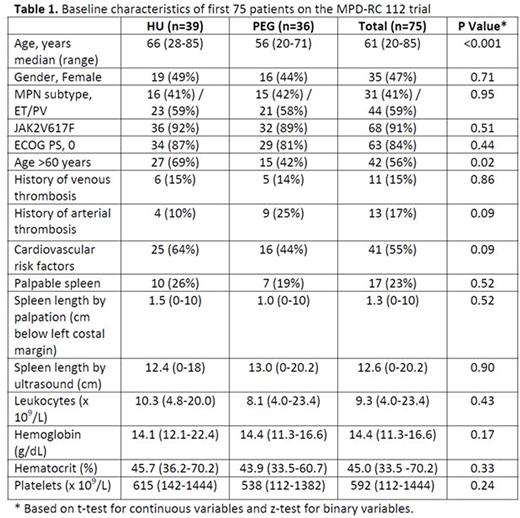Abstract
Background:
Cytoreductive therapy with hydroxyurea (HU) has been considered first line therapy for patients with high risk polycythemia vera (PV) and essential thrombocythemia (ET) since the results of the PVSG-08 trial demonstrated thrombotic risk reduction (Fruchtman SM et al 1997) for PV and PT1 for ET (Harrison CN et al 2005). Although HU is well tolerated by most patients and has been shown to reduce thrombotic risk in this setting, concern regarding the leukemogenic potential of this oral ribonucleotide reductase inhibitor balanced by the observation of molecular responses with interferon-α (IFN-α) led us to compare the clinical response and tolerability of pegIFN-α (PEG) and HU in a global, randomized, phase III trial.
Methods:
MPD-RC 112 trial (NCT01258856) enrolled patients with high risk (age >60 years, history of thrombosis, extreme thrombocytosis, symptomatic splenomegaly, uncontrolled cardiovascular risk factors), newly diagnosed (<5 years), WHO defined ET/PV that were treatment naïve (HU <3 months) and randomized (1:1) to PEG or HU. The primary endpoint was complete hematologic response (CHR) rate by European LeukemiaNet (ELN) criteria between the arms after 12 months of therapy. A planned interim analysis based on intent-to-treat with testing boundaries for efficacy and futility was conducted after 75 patients were on study for 12 months. Response assessment by ELN criteria were conducted by blinded review by 4 investigators (JM, RAM, AY, RH). Intent-to-treat analysis was conducted for efficacy endpoints (HU n=39; PEG n=36). Safety analysis included all patients who received treatment (HU n=36; PEG n=36).
Results:
Patients: The MPD-RC 112 trial involved 24 centers in 6 countries; enrollment began 09/2011 and concluded 7/2016 prior to full accrual due to study drug availability with 168 patients enrolled (Table 1 for 75 patients in the interim analysis). There was no imbalance between arms with respect to history of thrombosis, erythromelalgia, diabetes, hypertension, but age was significantly older on HU. This remained true when analyzing by ET/PV disease strata with the exception of diabetes which was slightly imbalanced within the PV cohort (HU 5/23, 22%; PEG 0/21, 0%; p<0.05).
Response: CHR and PHR were observed in 13 (33%) and 14 (36%) patients for an overall response rate (ORR) of 69% (27/39) for HU, and 10 (28%) and 19 (53%) for an ORR of 81% (29/36) for PEG (CHR comparison p=0.60 based on z-test which did not cross either testing boundary). 10 patients randomized to HU were not evaluable for 12-month response due to never initiating treatment (n=3) or early study discontinuation for AEs (n=1), patient withdrawal (n=5), or treatment non-compliance (n=1). 3 patients were not evaluable for response on PEG due to early study discontinuation for AEs (n=1), physician decision (n=1), or patient withdrawal (n=1). Excluding patients who never initiated treatment did not impact the primary endpoint comparison (HU 13/36, 36%; PEG 10/36, 28%; p=0.45). For ET, CHR and PHR were observed in 7 (44%) and 4 (25%) patient on HU, and 6 (40%) and 6 (40%) for PEG (CHR comparison p=0.83). For PV, CHR and PHR were observed in 6 (26%) and 10 (44%) patients on HU, and 4 (19%) and 13 (62%) for PEG (CHR comparison p=0.58). Normalization of spleen by palpation at 12 months was seen in 2/7 (29%) and 5/7 (71%) of the HU and PEG treated patients with palpable spleen at baseline, respectively. Among 38 PV patients, rate of phlebotomy use at 12 months was 0/18 (0%) vs 5/20 (20%) on HU and PEG (p=0.02). From baseline to best score through 12 months, 9/28 (32%) and 12/34 (35%) patients with data on HU and PEG, respectively, had a ≥50% reduction in MPN-SAF Total Symptom Score (p=0.79).
Toxicity: No Grade 4 AEs occurred in either treatment arm. Overall, Grade 3 AEs occurred in 5/36 (14%) HU patients and 16/36 (44%) PEG patients (Grade 3 hematologic: 4/36 [11%] HU vs 8/36 [22%] PEG; Grade 3 non-hematologic: 5/36 [14%] HU vs 16/36 [44%] PEG). See Table 2 for Grade 3 AEs regardless of attribution occurring in >10% of patients in either arm.
Conclusions:
This interim analysis does not show a clear difference in primary endpoint of CHR between HU and PEG. A comparative analysis of the quality of life and symptom burden will provide further insight into the tolerability of these agents (Mesa et al ASH 2016). The final results of this pivotal trial will provide necessary data required to firmly establish the optimal first line therapy for patients with high risk ET/PV.
Mascarenhas:CTI Biopharma: Research Funding; Janssen: Research Funding; Promedior: Research Funding; Roche: Research Funding; Novartis: Other: DSMB , Research Funding; Incyte: Other: Clinical Trial Steereing Committee, Research Funding. Mesa:Celgene: Research Funding; Promedior: Research Funding; CTI: Research Funding; Gilead: Research Funding; Incyte: Research Funding; Galena: Consultancy; Ariad: Consultancy; Novartis: Consultancy. Yacoub:Alexion: Honoraria; Seattle Genetics: Consultancy, Honoraria, Speakers Bureau; Incyte: Consultancy, Honoraria, Speakers Bureau. Harrison:Baxaltra: Consultancy, Honoraria, Speakers Bureau; Incyte Corporation: Honoraria, Speakers Bureau; Gilead: Honoraria, Speakers Bureau; Shire: Honoraria, Speakers Bureau; Novartis: Consultancy, Honoraria, Other: travel, accommodations, expenses, Research Funding, Speakers Bureau. McMullin:Novartis: Honoraria, Speakers Bureau. Vannucchi:Novartis: Honoraria, Speakers Bureau. Kiladjian:Novartis: Honoraria, Research Funding; AOP Orphan: Membership on an entity's Board of Directors or advisory committees, Research Funding. Mead:Novartis: Honoraria, Research Funding, Speakers Bureau. Kessler:Incyte: Honoraria. Ritchie:Celgene: Consultancy, Other: Travel, Accomodations, Expenses, Speakers Bureau; Incyte: Consultancy, Speakers Bureau; Novartis: Consultancy, Other: Travel, Accommodations, Expenses, Research Funding, Speakers Bureau; Ariad: Speakers Bureau; Pfizer: Consultancy, Research Funding; Astellas Pharma: Research Funding; Bristol-Meyers Squibb: Research Funding; NS Pharma: Research Funding. Schlenk:Amgen: Research Funding; Pfizer: Honoraria, Research Funding.
Author notes
Asterisk with author names denotes non-ASH members.



This feature is available to Subscribers Only
Sign In or Create an Account Close Modal